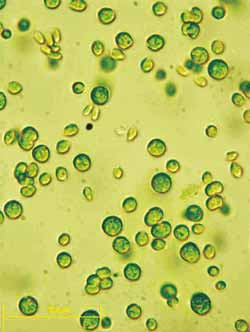Algae can draw energy from other plants

The alga Chlamydomonas reinhardtii is a single-cell organism. However, it can do something that other plants cannot do – as biologists at Bielefeld University have confirmed.<br><br>Bielefeld University<br>
Flowers need water and light to grow. Even children learn that plants use sunlight to gather energy from earth and water. Members of Professor Dr. Olaf Kruse’s biological research team at Bielefeld University have made a groundbreaking discovery that one plant has another way of doing this.
They have confirmed for the first time that a plant, the green alga Chlamydomonas reinhardtii, not only engages in photosynthesis, but also has an alternative source of energy: it can draw it from other plants. This finding could also have a major impact on the future of bioenergy. The research findings have been released on Tuesday 20 November in the online journal Nature Communications published by the renowned journal Nature.
Until now, it was believed that only worms, bacteria, and fungi could digest vegetable cellulose and use it as a source of carbon for their growth and survival. Plants, in contrast, engage in the photosynthesis of carbon dioxide, water, and light. In a series of experiments, Professor Dr. Olaf Kruse and his team cultivated the microscopically small green alga species Chlamydomonas reinhardtii in a low carbon dioxide environment and observed that when faced with such a shortage, these single-cell plants can draw energy from neighbouring vegetable cellulose instead.
The alga secretes enzymes (so-called cellulose enzymes) that ‘digest’ the cellulose, breaking it down into smaller sugar components. These are then transported into the cells and transformed into a source of energy: the alga can continue to grow. ‘This is the first time that such a behaviour has been confirmed in a vegetable organism’, says Professor Kruse. ‘That algae can digest cellulose contradicts every previous textbook. To a certain extent, what we are seeing is plants eating plants’. Currently, the scientists are studying whether this mechanism can also be found in other types of alga. Preliminary findings indicate that this is the case.
In the future, this ‘new’ property of algae could also be of interest for bioenergy production. Breaking down vegetable cellulose biologically is one of the most important tasks in this field. Although vast quantities of waste containing cellulose are available from, for example, field crops, it cannot be transformed into biofuels in this form. Cellulose enzymes first have to break down the material and process it. At present, the necessary cellulose enzymes are extracted from fungi that, in turn, require organic material in order to grow. If, in future, cellulose enzymes can be obtained from algae, there would be no more need for the organic material to feed the fungi. Then even when it is confirmed that algae can use alternative nutrients, water and light suffice for them to grow in normal conditions.
Contact:
Prof. Dr. Olaf Kruse, Bielefeld University
Faculty of Biology/Algae Biotechnology and Bioenergy
Telephone: +49 521 106-2257
Email: olaf.kruse@uni-bielefeld.de
Media Contact
All latest news from the category: Life Sciences and Chemistry
Articles and reports from the Life Sciences and chemistry area deal with applied and basic research into modern biology, chemistry and human medicine.
Valuable information can be found on a range of life sciences fields including bacteriology, biochemistry, bionics, bioinformatics, biophysics, biotechnology, genetics, geobotany, human biology, marine biology, microbiology, molecular biology, cellular biology, zoology, bioinorganic chemistry, microchemistry and environmental chemistry.
Newest articles

High-energy-density aqueous battery based on halogen multi-electron transfer
Traditional non-aqueous lithium-ion batteries have a high energy density, but their safety is compromised due to the flammable organic electrolytes they utilize. Aqueous batteries use water as the solvent for…

First-ever combined heart pump and pig kidney transplant
…gives new hope to patient with terminal illness. Surgeons at NYU Langone Health performed the first-ever combined mechanical heart pump and gene-edited pig kidney transplant surgery in a 54-year-old woman…

Biophysics: Testing how well biomarkers work
LMU researchers have developed a method to determine how reliably target proteins can be labeled using super-resolution fluorescence microscopy. Modern microscopy techniques make it possible to examine the inner workings…





















